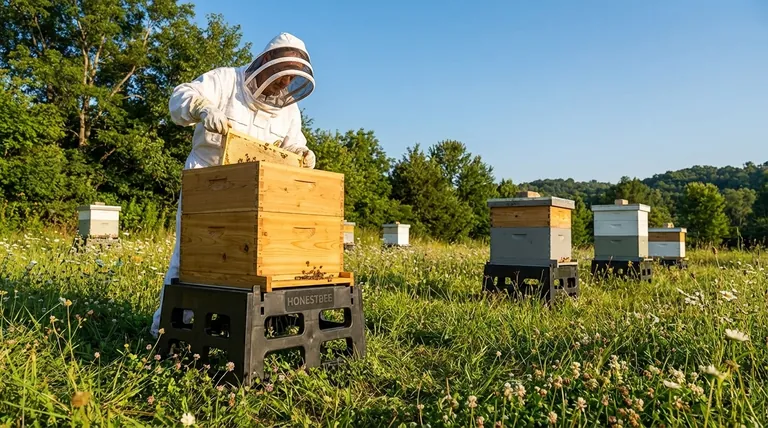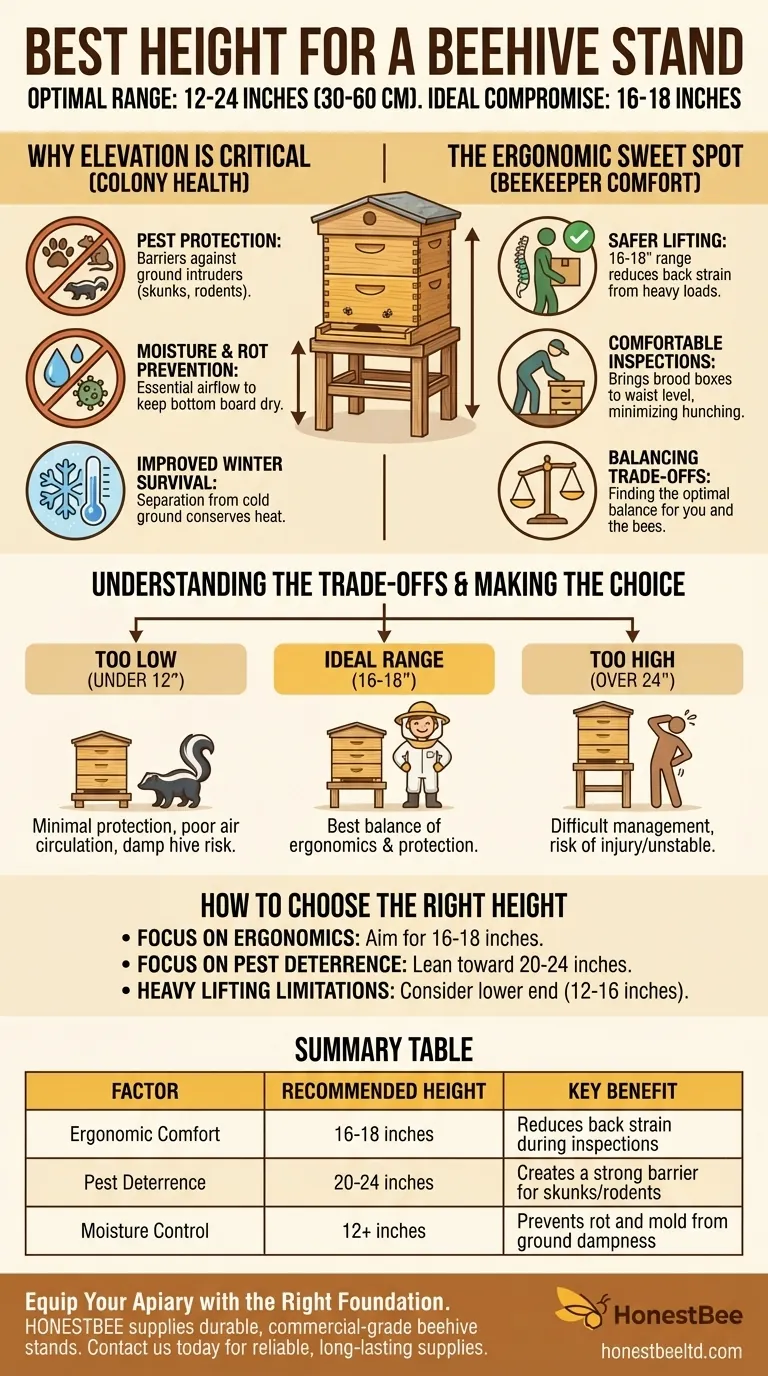The best height for a beehive stand is typically between 12 and 24 inches (30 to 60 cm) off the ground. Most experienced beekeepers find that a height of 16 to 18 inches provides the ideal compromise between hive protection, moisture control, and the beekeeper's own physical comfort during inspections and management.
Choosing a beehive stand height isn't about a single magic number, but about finding the optimal balance between the health of your colony and the physical demands of beekeeping.

Why Hive Elevation Is Critical
Elevating your hive off the ground is a fundamental step in responsible beekeeping. It directly impacts the colony's safety, health, and long-term viability by mitigating several key environmental threats.
Protecting the Colony from Pests
Placing a hive directly on the ground is an open invitation for pests. A stand creates a crucial barrier against common threats like skunks, raccoons, and rodents that can harass or destroy a colony.
Even a modest height of 12 inches is often enough to deter these ground-level intruders, safeguarding your bees and their resources.
Preventing Moisture and Rot
Hives need to stay dry. A stand promotes essential airflow underneath the hive, preventing moisture from wicking up from the damp ground.
This circulation keeps the bottom board dry, which is critical for preventing wood rot and inhibiting the growth of harmful mold and mildew inside the hive.
Improving Winter Survival
Getting the hive off the cold, frozen ground is especially important in cooler climates. This separation helps the colony conserve heat and energy during the winter, as they don't have to fight the constant cold radiating from the earth.
Finding the Ergonomic Sweet Spot
While hive health is paramount, the stand's height also directly affects your ability to manage the hive effectively and without injury.
The Impact on Lifting
Beekeeping involves heavy lifting. A full deep hive body can weigh over 80 pounds, and honey supers can be 40-60 pounds each.
A stand in the 16 to 18-inch range places the heaviest lifting in a more ergonomic zone, reducing strain on your back compared to lifting from ground level.
The Comfort of Hive Inspections
During a hive inspection, you will be bent over the open hive for extended periods. A stand that is too low forces you into an uncomfortable hunch, leading to significant back pain.
A height that brings the top of the brood boxes closer to your waist level makes inspections far more comfortable and sustainable.
Understanding the Trade-offs
Choosing a height involves balancing competing factors. Going too high or too low introduces different sets of problems.
The Risk of Going Too Low (Under 12 inches)
A stand below 12 inches offers minimal protection. It may not be high enough to deter a determined skunk and provides less effective air circulation, increasing the risk of a damp hive.
The Challenge of Going Too High (Over 24 inches)
While a very high stand offers excellent pest protection, it can make hive management difficult. Lifting heavy honey supers above your chest level is awkward and increases the risk of injury or dropping a box.
Furthermore, a tall hive can become top-heavy and less stable, particularly in areas prone to high winds.
How to Choose the Right Height for Your Apiary
Consider your primary goals and physical environment when making a final decision.
- If your primary focus is ergonomic comfort: Aim for the 16 to 18-inch range, which minimizes back strain for most people during inspections.
- If your primary focus is pest deterrence in a high-risk area: Lean toward the upper end of the range, around 20 to 24 inches, to create a more significant barrier.
- If you anticipate very heavy honey supers or have lifting limitations: Consider staying on the lower end, around 12 to 16 inches, to reduce the lifting height required for the top boxes.
Ultimately, the right stand makes beekeeping safer for the colony and more sustainable for you.
Summary Table:
| Factor | Recommended Height | Key Benefit |
|---|---|---|
| Ergonomic Comfort | 16-18 inches | Reduces back strain during inspections |
| Pest Deterrence | 20-24 inches | Creates a strong barrier for skunks/rodents |
| Moisture Control | 12+ inches | Prevents rot and mold from ground dampness |
Equip Your Apiary with the Right Foundation
Choosing the correct hive stand is crucial for protecting your investment and ensuring your comfort. At HONESTBEE, we supply durable, commercial-grade beehive stands and apiary equipment designed for the demanding needs of commercial apiaries and beekeeping equipment distributors.
Our wholesale-focused operations ensure you get reliable, long-lasting supplies that support healthy colonies and efficient hive management.
Contact HONESTBEE today to discuss your beekeeping supply needs and secure the best equipment for your operation.
Visual Guide

Related Products
- Plastic Bee Hive Stand for Beekeeping
- Metal Hive Feet Bee Hive Stand for Ant Protection
- Metal Bee Hive Stand Bee Box Stand for Beekeeping
- Wholesales Dadant Size Wooden Bee Hives for Beekeeping
- Professional Ant-Proof Beehive Stand with Integrated Moat for Beekeeping
People Also Ask
- How do bees regulate ventilation and temperature in the hive? Master Hive Climate Control
- What is the purpose of a hive stand in a Langstroth hive? Protect Your Hive and Boost Colony Health
- How do bees regulate the temperature of their hive during the summer? Discover Their Natural Cooling System
- How does the longevity of plastic bee hives compare to wooden hives? Discover the Durable Choice
- Why is elevating the hive important? A Simple Step for a Healthier, More Productive Colony



















